HiSilicon Kirin 960: A Closer Look at Performance and Power
by Matt Humrick on March 14, 2017 7:00 AM EST- Posted in
- Smartphones
- Mobile
- SoCs
- HiSilicon
- Cortex A73
- Kirin 960
Memory Performance
ARM made several improvements to the A73’s memory system. Both L1 caches see an increase in size, with the I-cache growing from 48KB (A72) to 64KB and the D-cache doubling in size to 64KB. The A73 includes several other changes, such as enhanced prefetching, that should improve cache performance too.
The A73 still has 2 AGUs like the A72, but they are now capable of both load and store operations instead of having each AGU dedicated to a single operation like in the A72, which should improve the issue rate into main system memory.
The Kirin 960’s larger 64KB L1 cache maintains a steady latency of 1.27ns versus 1.74ns for the Kirin 950, a 27% improvement that far exceeds the 2.6% difference in CPU frequency, highlighting the A73’s L1 cache improvements. L2 cache latency is essentially the same, but Kirin 960 again shows a 27% latency improvement over Kirin 950 when accessing main memory, which should be beneficial for the latency sensitive CPUs.
Memory bandwidth results are less definitive, however. The Kirin 960 shows up to a 30% improvement in L1 read bandwidth over the Kirin 950 depending on the access pattern used, although L1 write bandwidth is lower by nearly the same amount. The 960’s L2 cache bandwidth is also lower for both read and write by up to about 30%.
The two graphs above, which show reading and writing NEON instructions using two threads, help to illustrate Kirin 960’s memory bandwidth. When reading instructions, Kirin 960’s L1 cache outperforms the 950’s, but bandwidth drops once it hits the L2 cache. The Kirin 950 outpaces the 960 when writing to both L1 and L2, only falling below the 960’s bandwidth when writing to system memory. This reduction in cache bandwidth could help explain the Kirin 960’s performance regression in several of Geekbench 4’s floating-point tests.
| Geekbench 4 - Memory Performance Single Threaded |
||||
| Kirin 960 | Kirin 950 (% Advantage) |
Exynos 7420 (% Advantage) |
Snapdragon 821 (% Advantage) |
|
| Memory Copy | 4.55 GB/s | 3.67 GB/s (23.87%) |
3.61 GB/s (26.04%) |
7.82 GB/s (-41.84%) |
| Memory Latency | 12.1 Mops/s | 9.6 Mops/s (25.39%) |
5.6 Mops/s (115.67%) |
6.6 Mops/s (81.82%) |
| Memory Bandwidth | 15.5 GB/s | 9.2 GB/s (69.28%) |
7.5 GB/s (105.84%) |
13.5 GB/s (14.53%) |
While the Kirin 960’s L1/L2 cache performance is mixed, it holds a clear advantage over the Kirin 950 when using system memory. Memory latency improves by 25%, about the same amount our internal testing shows, and memory bandwidth improves by 69%. The A73’s two load/store AGUs are likely responsible for a large chunk of the additional memory bandwidth, with the Mate 9’s higher memory bus frequency helping some too.
System Performance
Now it’s time to see how Kirin 960’s lower-level CPU and memory results translate into real-world performance, keeping in mind that OEMs can influence the balance between performance and battery life in a number of ways, including adjusting thermal limits and parameters that govern CPU scheduler and DVFS behavior, which is one reason why two devices with the same SoC can perform differently.
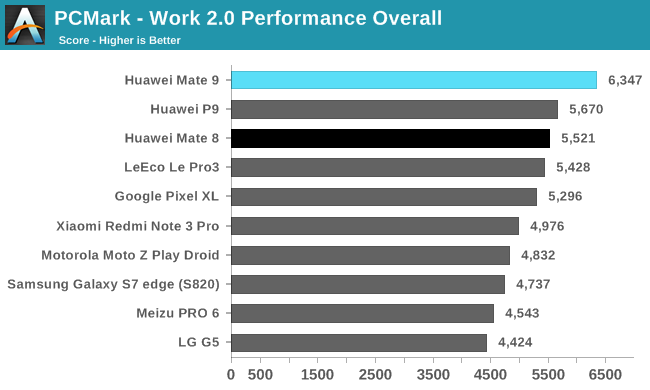
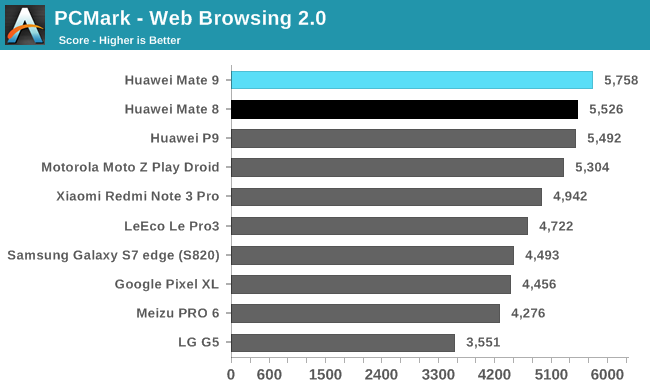
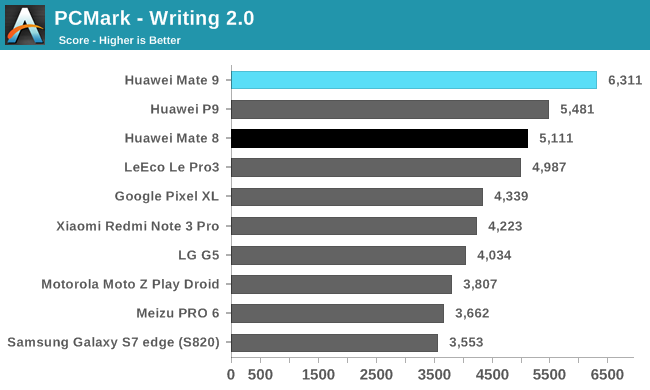
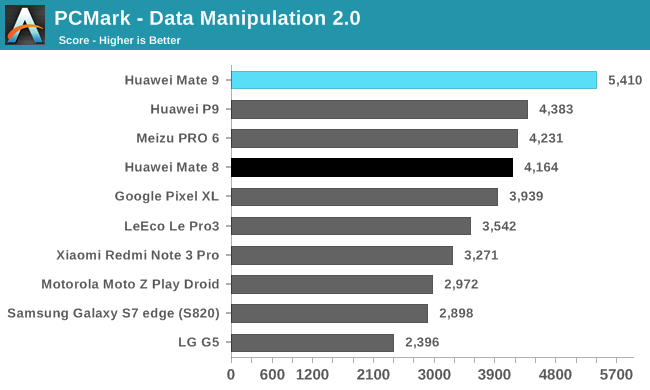
PCMark includes several realistic workloads that stress the CPU, GPU, RAM, and NAND storage using Android API calls many common apps use. The Mate 9 and its Kirin 960 SoC land at the top of each chart, outpacing the Mate 8 and its Kirin 950 by 15% overall and the top-performing Snapdragon 821 phones by up to 20%.
The Mate 9’s advantage over the Mate 8 is only 4% in the Web Browsing test, but it’s still the fastest phone we’ve tested so far. Integer performance is not the Kryo CPU’s strength, and in this integer-heavy test all of the Snapdragon 820/821 phones fall behind SoCs using ARM’s A72 and A73 CPUs, with LeEco’s Le Pro3, the highest performing Snapdragon 821 phone, finishing 18% slower than the Mate 9.
The Writing test performs a variety of operations, including PDF processing and file encryption (both integer workloads), along with some memory operations and even reading and writing some files to internal NAND, and it tends to generate frequent, short bursts of activity on the big CPU cores. This seems to suit the Mate 9 just fine, because it extends its performance advantage over the Mate 8 to 23%. There’s a pretty big spread between the Snapdragon 820/821 phones; the LeEco Le Pro3, the best performer in the family, is 40% faster than the Galaxy S7 edge, a prime example of how other hardware components and OEM software tinkering can affect the overall user experience.
The Data Manipulation test is another primarily integer workload that measures how long it takes to parse chunks of data from several different file types and then records the frame rate while interacting with dynamic charts. In this test, the Mate 9 is 30% faster than the Mate 8 and 37% faster than the Pixel XL.
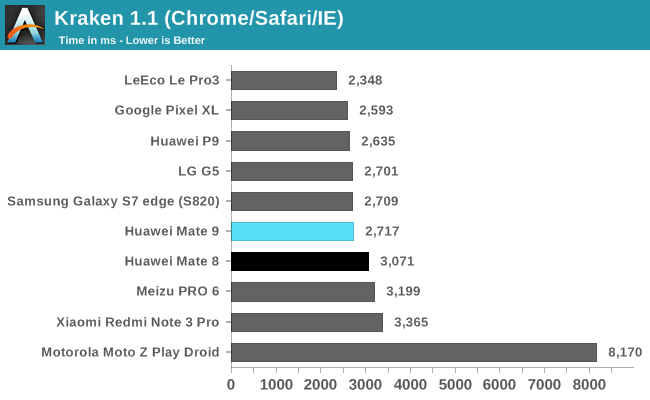
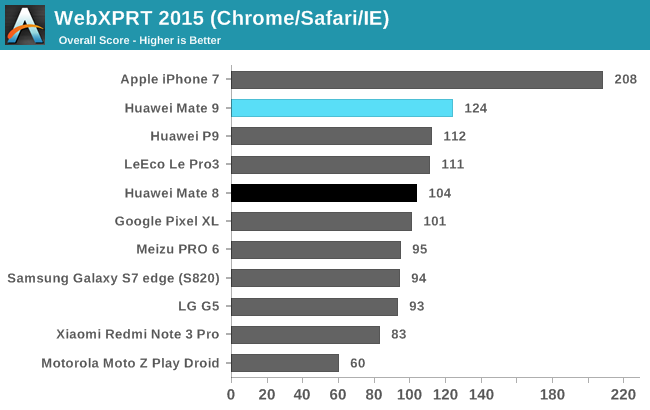
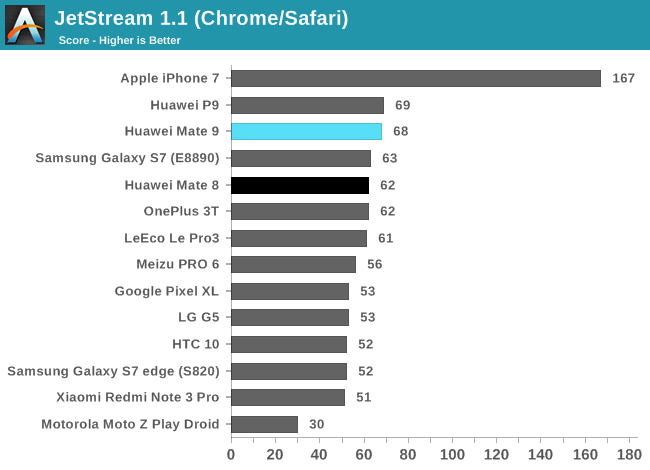
All of the Snapdragon 820/821 phones perform well in the Kraken JavaScript test, pulling ahead of the Mate 9 by a small margin. The P9 uses Kirin 955’s 7% CPU frequency advantage to help it keep up with the Mate 9 in Kraken and JetStream. The Mate 9 still pulls ahead by 11% in WebXPRT 2015, though, and outperforms the Mate 8 by 10% to 19% in all three tests. The Moto Z Play Droid, the only phone in the charts to use an octa-core A53 CPU configuration, cannot even manage half the performance of the Mate 9, which is similar to what our integer IPC tests show.
The Kirin 960 showed mixed results in our lower-level CPU and memory testing, pulling ahead of the Kirin 950 in some areas while falling behind in others. But when looking at system level tests using real-world workloads, the Mate 9 and its Kirin 960 are the clear winners. There are many hardware and software layers between you and the SoC, which is why it’s important not to use an SoC benchmark to test system performance and a system benchmark, such as PCMark, to test CPU performance.


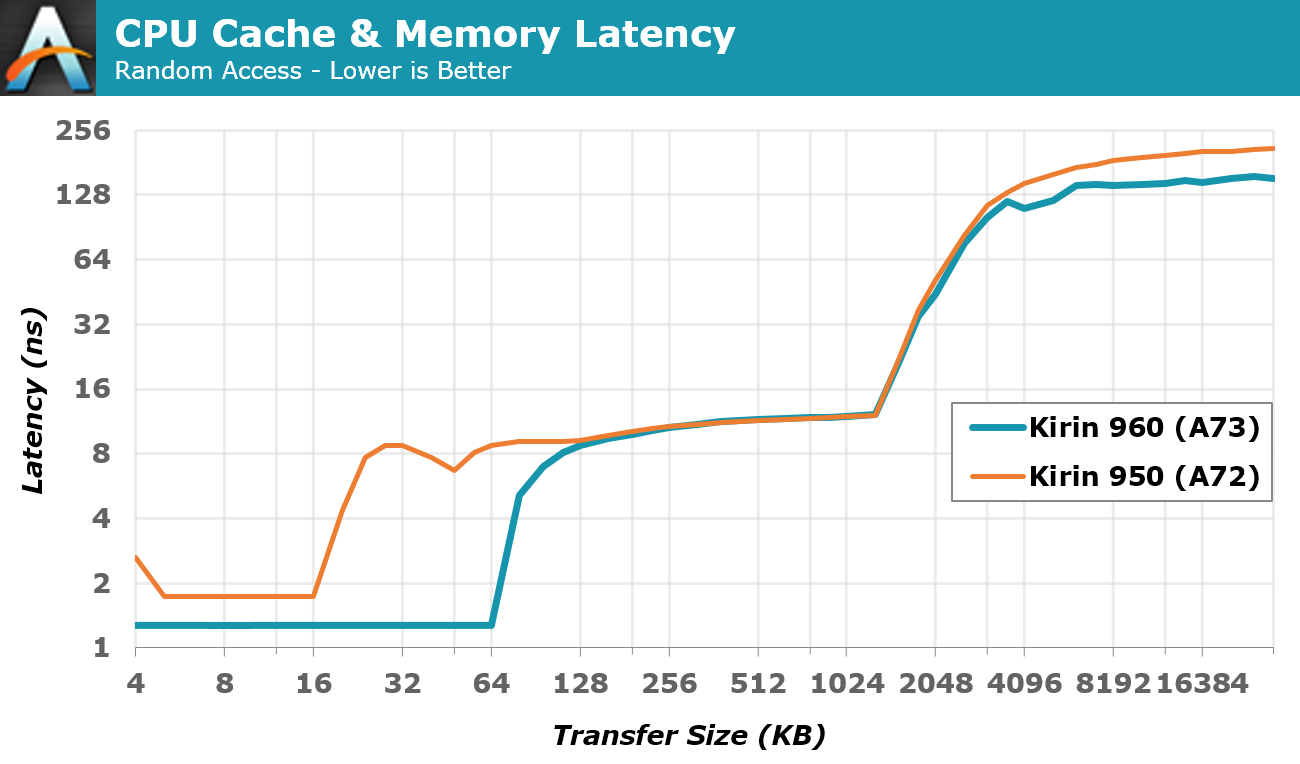
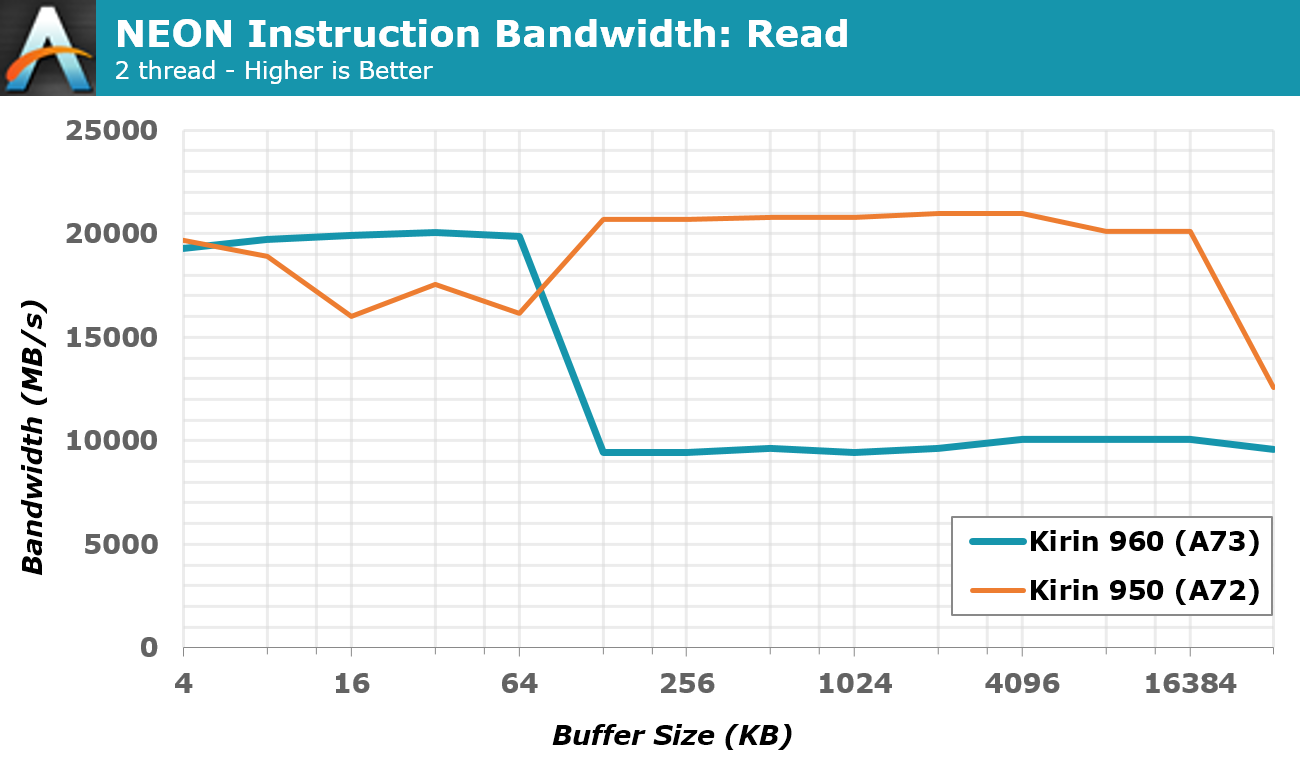









86 Comments
View All Comments
lilmoe - Tuesday, March 14, 2017 - link
I read things thoroughly before criticizing. You should do the same before jumping in to support an idiotic comment like fanofanand's. He's more interested in insulting people than finding the truth.These tests are the ones which aren't working. No one gets nearly as much battery life as they report. Nor are the performance gains anywhere near what benchmarks like geekbench are reporting. If something isn't working, one should really look for other means. That's how progress works.
You can't test a phone the same way you test a workstation. You just can't. NO ONE leaves their phone lying on a desk for hours waiting on it to finish compiling 500K lines of code, or rendering a one-hour 3D project or a 4K video file for their channel on Youtube. But they do spend a lot of time watching video on Youtube, browsing the web with 30 second pauses between each scroll, and uploading photos/videos to social media after applying filters. Where are these tests??? You know, the ones that actually MATTER for most people? You know, the ones that ST performance matters less for, etc, etc...
Anyway, I did suggest what I believe is a better, more realistic, method for testing. Hint, it's in the fifth paragraph of my original reply. But who cares right? We just want to know "which is the fastest", which method confirms our biases, regardless of the means of how such performance is achieved. Who cares about the truth.
People are stubborn. I get that. I'm stubborn too. But there's a limit at how stubborn people can be, and they need to be called out for it.
Meteor2 - Wednesday, March 15, 2017 - link
I'm with fanof and close on this one. Here we have a consistent battery of repeatable tests. They're not perfectly 'real-world' but they're not far off either; there's only so many things a CPU can do.I like this test suite (though I'd like to see GB/clock and SPi and GB/power calculated and graphed too). If you can propose a better one, do so.
close - Wednesday, March 15, 2017 - link
This isn't about supporting someone's comment, I was very clear which part I agree with: the one where you help come up with a practical implementation of your suggestion.Phone can and should be tested like normal desktops since the vast majority of them spend most of their time idling, just like phones. The next this is running Office like applications, normal browsing, and media consumption.
You're saying that "NO ONE leaves their phone lying on a desk for hours waiting on it to finish compiling 500K lines of code". But how many people would find even that relevant? How many people compile 500K lines of code regularly? Or render hours of 4K video? And I'm talking about percentage of the total.
Actually the ideal case for testing any device is multiple scenarios that would cover a more user types: from light browsing and a handful of phone calls to heavy gaming or media consumption. These all result in vastly different results as a SoC/phone might be optimized for sporadic light use or heavier use for example. So a phone that has best battery life and efficiency while gaming won't do so while browsing. So just like benchmarks, any result would only be valid for people who follow the test scenario closely in their daily routine.
But the point wasn't whether an actual "real world" type scenario is better, rather how exactly do you apply that real world testing into a sequence of steps that can be reproduced for every phone consistently? How do you make sure that all phones are tested "equally" with that scenario and that none has an unfair (dis)advantage from the testing methodology? Like Snapchat or FB being busier one day and burning through the battery faster.
Just like the other guy was more interested in insults (according to you), you seem more interested in cheap sarcasm than in actually providing an answer. I asked for a clear methodology. You basically said that "it would be great if we had world peace and end hunger". Great for a beauty pageant, not so great when you were asked for a testing methodology. A one liner is not enough for this. A methodology is you describing exactly how you proceed with testing the phones, step by step, while guaranteeing reproducibility and fairness. Also please explain how opening a browser, FB, or Snapchat is relevant for people who play games 2 hours per day, watch movies or actually use the phone as a phone and talk to other people.
You're making this more difficult than it should be. You look like you had plenty of time to think about this. I hald half a day and already I came up with a better proposal then yours (multiple scenarios vs. single scenario). And of course, I will also leave out the exact methodology part because this is a comment competition not an actual search for solutions.
lilmoe - Wednesday, March 15, 2017 - link
I like people who actually spend some time to reply. But, again, I'd appreciate it more if you read my comments more carefully. I told you that the answer you seek is in my first reply, in the fifth paragraph. If you believe I have "plenty of time" just for "cheap sarcasm", then sure we can end it here. If you don't, then go on reading.I actually like this website. That's why I go out of my way to provide constructive criticism. If I was simply here for trolling, my comments won't be nearly as long.
SoCs don't live in a vacuum, they come bundled with other hardware and software (Screen, radios, OS/Kernel), optimized to work on the device being reviewed. In the smartphone world, you can't come to a concrete conclusion on the absolute efficiency of a certain SoC based on one device, because many devices with the same SoC can be configured to run that SoC differently. This isn't like benchmarking a Windows PC, where the kernel and governer are fixed across hardware, and screens are interchangeable.
Authors keep acknowledging this fact, yet do very little to go about testing these devices using other means. It's making it hard for everyone to understand the actual performance of said devices, or the real bang for the buck they provide. I think we can agree on that.
"You're making this more difficult than it should be"
No, really, I'm not. You are. When someone is suggesting something a bit different, but everyone is slamming them for the sake of "convention" and "familiarity", then how are we supposed to make progress?
I'm NOT saying that one should throw benchmarks out. But I do believe that benchmarks should stay in meaningful context. They give you a rough idea about the snappiness of a ultra-mobile device, since it's been proven time after time that the absolute performance of these processors is ONLY needed for VERY short bursts, unlike workstations. However, they DO NOT give you anywhere near a valid representation of average power draw and device battery life, and neither do scripts written to run synthetic/artificial workloads. Period.
This is my point. I believe the best way to measure a specific configuration is by first specifying the performance point a particular OEM is targeting, and then measuring the power draw of that target. This comes in as the average clocks the CPU/GPU at various workloads, from gaming, browsing, playing video, to social media. It doesn't matter how "busy" these content providers are at specific times, the average clocks will be the same regardless because the workload IS the same.
I have reason to believe that OEMs are optimizing their kernels/governers for each app alone. Just like they did with benchmarks several years ago, where they ramp clocks up when they detect a benchmark running. Except, they're doing it the right way now, and optmizing specific apps to run differently on the device to provide the user with the best experience.
When you've figured out the average the OEM is targetting for various workloads, you'd certainly know how much power it's drawing, and how much battery life to expect AFTER you've already isolated other factors, such as the screen and radios. It also makes for a really nice read, as a bonus (hence, "worth investigating").
This review leaves an important question unanswered about this SoC's design (I'm really interested to know the answer); did HiSilicon cheap out on the fab process to make more money and leach on the success of its predecessor? Or did they do that with good intentions to optimize their SoC further for modern, real world workloads that currently used benchmarks are not detecting? I simply provided a suggest to answer that question. Does that warrant the language in his, or your reply? Hence my sarcasm.
fanofanand - Tuesday, March 14, 2017 - link
It's exciting to see the envelope being pushed, and though these are some interesting results I like that they are pushing forward and not with a decacore. The G71 looks like a botched implementation if it's guzzling power that heavily, I wonder if some firmware/software could fix that? A73 still looks awesome, and I can't wait to see a better implementation!psychobriggsy - Tuesday, March 14, 2017 - link
TBH the issue with the GPU appears to be down to the clock speed it is configured with.It's clear that this is set for benchmarking purposes, and it's good that this has been caught.
Once the GPU settles down into a more optimal 533MHz configuration, power consumption goes down significantly. Sadly it looks like there are four clock settings for the GPU, and they've wasted three of them on stupid high clocks. A better setup looks to be 800MHz, 666MHz, 533MHz and a power saving 400MHz that most Android games would still find overkill.
Meteor2 - Wednesday, March 15, 2017 - link
Performance/Watt is frankly rubbish whatever the clock speed. Clearly they ran out of time or money to implement Bifrost properly.fanofanand - Wednesday, March 15, 2017 - link
That's what I'm thinking, I read the preview to Bitfrost and thought "wow this thing is going to be killer!" I was right on the money, except that it's a killer of batteries, not competing GPUs.Shadowmaster625 - Tuesday, March 14, 2017 - link
What is HTML5 DOM doing that wrecks the Snapdragon 821 so badly?joms_us - Tuesday, March 14, 2017 - link
Just some worthless test that the Monkey devs put to show how awesome iPhones are. But if you do real side-by-side website comparison between iPhone and and phone with SD821, SD821 will wipe the floor.